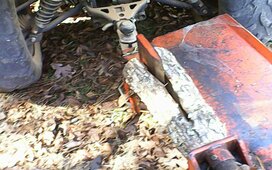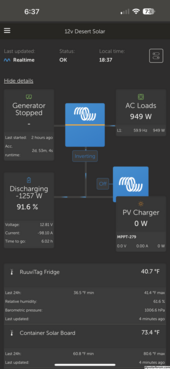Hi all,
I've been a Victron fan since day one, and am still happy that I bought it for my small (1.26 KW) "shed" system. But I was surprised (OK, disappointed) to find that my 3000 KVA Multiplus wimped out today as I tried to use it with a small (5-ton) electric (hydraulic) log splitter. The system was drawing just over 100 W of AC and the sun was bright. Batteries (three 24V 100 AH Amperetime in parallel, with 1/0 AWG cables) were at 100% SOC. Battery assist was turned on but there as no AC (shore power) running into the Multiplus. I plugged the log splitter into a 20A circuit about 12 wire feet away from the panel, and fired up the splitter. It sounded strained, and in about 3 seconds the Multiplus overload tripped. It reset itself perhaps 20-30 seconds later, so I tried again. No joy. This happened 4-5 times before I wheeled the splitter to the garage, plugged it into a 20A AC circuit, and it worked. To experiment, I then tried it with a 25 foot 12 Ga extension cord, then a 25 ft 14 ga, and finally a 50 ft 14 ga. cord, to see if that made a difference and caused it to fail. It worked fine. Wheeled it back to the shed, tried it on the Multiplus again, and no-go. At least I know the overload protection works well...
One of the main reasons I bought Victron was the low frequency transformer, and its (alleged) ability to handle surge loads.I still think Victron is great equipment, but I have to say, this did not help its case as I ponder whether to buy Victron or EG4 for the new house. I'm certainly not suggesting EG4 would be better. But it sure is a lot less expensive, and the low frequency inverter didn't help at all today. The new house will have a Grundfos SQ well pump, so this splitter might be the biggest thing I use there other than the Mig welder. I do wonder if this could have been a battery issue, but I'm skeptical, as the internal BMS didn't kick in. Instead, it was the Multiplus overload protection. Maybe I'll connect shore power in a few days and see if that makes a difference. But right now, I'm a little bit disappointed.
I've been a Victron fan since day one, and am still happy that I bought it for my small (1.26 KW) "shed" system. But I was surprised (OK, disappointed) to find that my 3000 KVA Multiplus wimped out today as I tried to use it with a small (5-ton) electric (hydraulic) log splitter. The system was drawing just over 100 W of AC and the sun was bright. Batteries (three 24V 100 AH Amperetime in parallel, with 1/0 AWG cables) were at 100% SOC. Battery assist was turned on but there as no AC (shore power) running into the Multiplus. I plugged the log splitter into a 20A circuit about 12 wire feet away from the panel, and fired up the splitter. It sounded strained, and in about 3 seconds the Multiplus overload tripped. It reset itself perhaps 20-30 seconds later, so I tried again. No joy. This happened 4-5 times before I wheeled the splitter to the garage, plugged it into a 20A AC circuit, and it worked. To experiment, I then tried it with a 25 foot 12 Ga extension cord, then a 25 ft 14 ga, and finally a 50 ft 14 ga. cord, to see if that made a difference and caused it to fail. It worked fine. Wheeled it back to the shed, tried it on the Multiplus again, and no-go. At least I know the overload protection works well...
One of the main reasons I bought Victron was the low frequency transformer, and its (alleged) ability to handle surge loads.I still think Victron is great equipment, but I have to say, this did not help its case as I ponder whether to buy Victron or EG4 for the new house. I'm certainly not suggesting EG4 would be better. But it sure is a lot less expensive, and the low frequency inverter didn't help at all today. The new house will have a Grundfos SQ well pump, so this splitter might be the biggest thing I use there other than the Mig welder. I do wonder if this could have been a battery issue, but I'm skeptical, as the internal BMS didn't kick in. Instead, it was the Multiplus overload protection. Maybe I'll connect shore power in a few days and see if that makes a difference. But right now, I'm a little bit disappointed.






